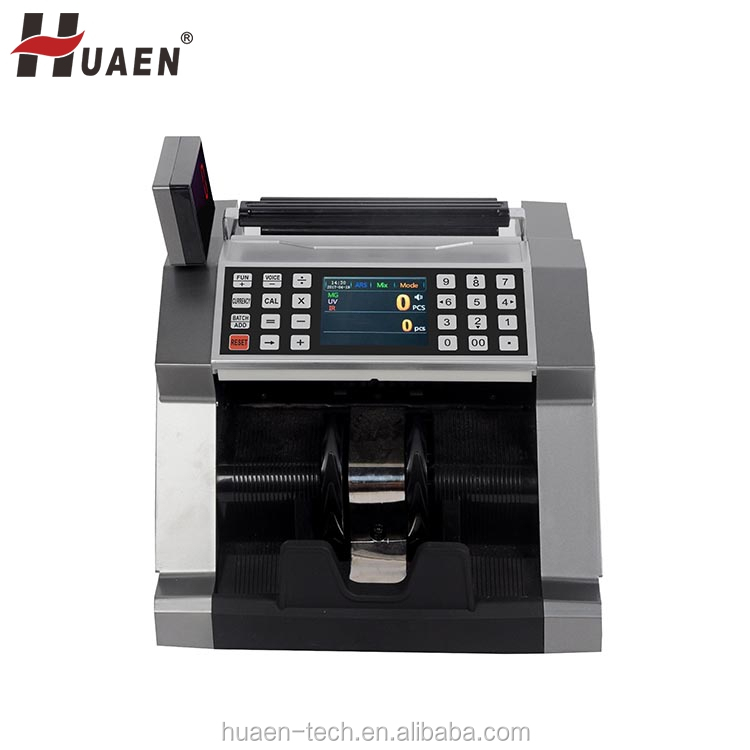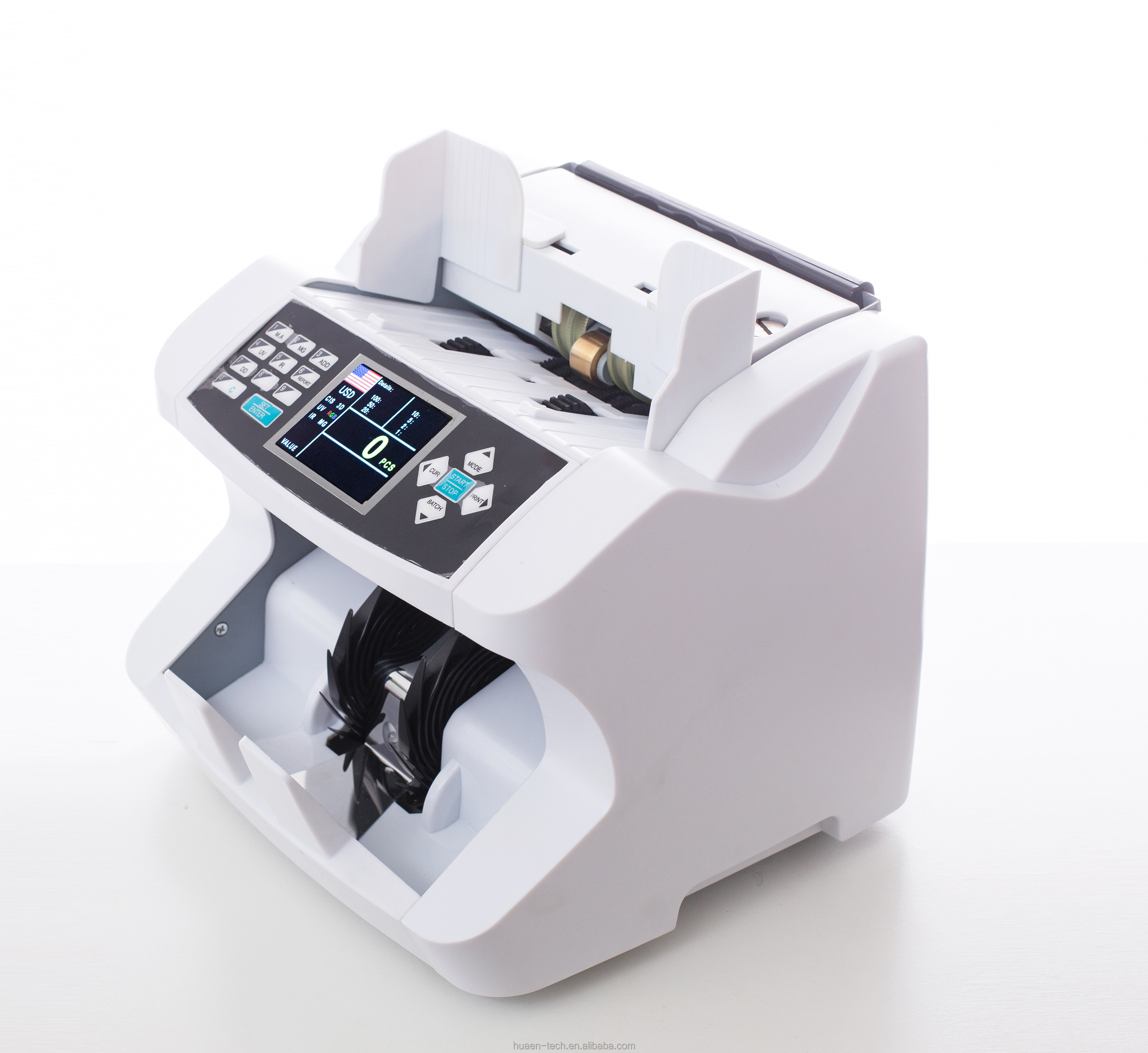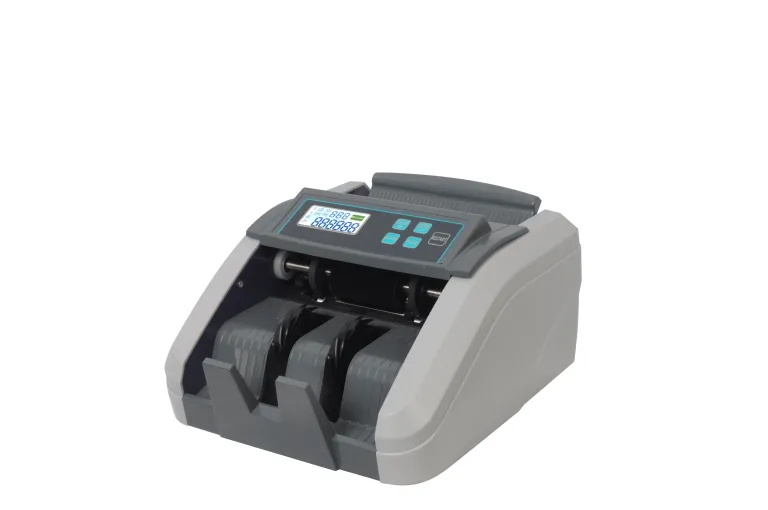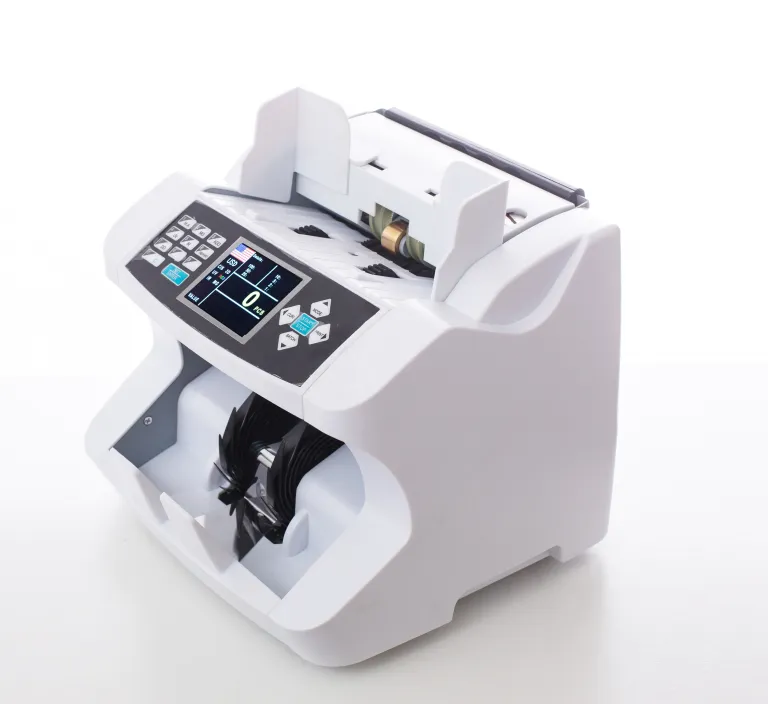HUAEN - Professional Money Counter/Currency Counter Manufacturing and Exporting on Since 2008
What Is Bill Counter with Counterfeit Detection?
In Anhui Chenguang Electronic Technology Co.,Ltd, the bill counter with counterfeit detection is the star product. It is the concentration of our advanced production technique, standard manufacturing, and stringent quality control. All these are keys for its excellent performance and wide but specific applications. 'The users are attracted by its looking and functions,' said one of our purchasers, 'With increasing sales, we would like to order much more to guarantee the supply sufficiency.'
Thanks to the trust and support of customers, Huaen has strong brand positioning in the international market. Customers' feedback on products promotes our development and keeps customers coming back repeatedly. Though these products are sold in a huge amount, we hold on quality products to retain customers' preference. 'Quality and Customer First' is our service rule.
We have a strong leadership team focused on delivering satisfying product and customer service through HUAEN. We value our highly qualified, dedicated and flexible workforce and invest in their continued development to ensure project delivery. Our access to an international workforce supports a competitive cost structure.
Imagine handling a pile of cash with varying denominations. Sorting and counting manually can be tedious and error-prone. Enter the mixed denomination money counter. This device revolutionizes cash handling by swiftly counting and sorting multiple currency denominations in one go. Whether you're managing daily cash flow in a retail store or handling large sums in a bank, a mixed denomination money counter can make your life easier.
These machines are designed to recognize and tally different denominations automatically, ensuring accuracy and efficiency. They streamline cash management, saving time and reducing human errors.
Types Of Mixed Denomination Money Counters
Mixed denomination money counters come in a variety of models to suit different business needs. Understanding the types available can help you make an informed decision.

Portable vs. Stationary Models
Mixed denomination money counters come in various types, including portable and stationary models. Portable models are lightweight and easy to transport, making them ideal for businesses that need flexibility in their cash-handling operations. These models are perfect for mobile businesses, event organizers, and small retailers.
On the other hand, stationary models are designed for high-volume cash handling and are typically found in banks, large retail stores, and casinos. These models offer advanced features and higher processing speeds, making them suitable for environments where large amounts of cash are handled regularly.
Basic vs. Advanced Models
The features of mixed denomination money counters can vary widely, from basic to advanced models. Basic models typically offer essential functions such as counting and sorting, making them suitable for small businesses with straightforward cash-handling needs.
Advanced models, however, come with a host of additional features, including counterfeit detection, multi-currency detection, and batch processing capabilities. These models are designed for businesses with more complex cash-handling requirements and can significantly enhance operational efficiency. Choosing between basic and advanced models depends on the specific needs and budget of the business.
Key Features Of Mixed Denomination Money Counters
Let's dive into the key features that make mixed denomination money counters indispensable tools for modern businesses.
Multi-Currency Detection
One of the standout features of mixed denomination money counters is their ability to detect multiple currencies. This capability is crucial for businesses operating in global markets or those that handle international transactions. These machines use advanced sensors and software algorithms to recognize and count different currencies, ensuring precise totals.
The ability to handle multiple currencies enhances a business's flexibility and reduces the risk of errors in currency exchange processes. This feature is especially beneficial for banks, currency exchange offices, and international retailers.
Speed and Accuracy
When it comes to counting money, speed and accuracy are paramount. Mixed denomination money counters excel in both areas. These machines can process hundreds of bills per minute, significantly faster than manual counting.
This rapid processing doesn't compromise accuracy; in fact, it's enhanced by sophisticated sensors and software that minimize errors. The combination of speed and accuracy ensures that businesses can manage their cash flow efficiently, reducing the time spent on cash handling and allowing staff to focus on more critical tasks.

Counterfeit Detection
Counterfeit money is a significant concern for any business handling cash. Mixed denomination money counters come equipped with advanced counterfeit detection features, utilizing ultraviolet (UV), magnetic (MG), and infrared (IR) sensors. These sensors can detect various security features embedded in legitimate currency, such as watermarks, micro-printing, and magnetic inks.
By identifying counterfeit bills, these machines protect businesses from potential losses and enhance overall financial security. The inclusion of counterfeit detection is a critical feature that adds an extra layer of protection in cash transactions.
Batch Processing and Sorting
Mixed denomination money counters offer batch processing and sorting capabilities, further streamlining cash handling processes. Batch processing allows users to count and sort large volumes of cash in predefined batches, making it easier to organize and manage cash deposits. Sorting capabilities enable the machine to separate bills by denomination, condition, or orientation, depending on the model.
This feature is particularly useful for businesses that need to prepare cash for deposits, ensuring that each batch meets specific criteria. The ability to process and sort cash efficiently reduces manual labor and improves overall operational efficiency.
Benefits Of Using A Mixed Denomination Money Counter
Now, let's explore the various benefits that make mixed denomination money counters a valuable addition to any business.
Increased Efficiency
Using a mixed denomination money counter significantly boosts efficiency in cash handling operations. These machines automate the tedious task of counting and sorting bills, freeing up employees to focus on other important duties.
The speed and accuracy of these counters mean that businesses can process cash transactions faster, reducing wait times for customers and improving overall service quality. The increased efficiency also translates to cost savings, as businesses can reduce the amount of time and resources spent on manual cash-handling tasks.
Enhanced Security
Security is a major concern for any business dealing with cash. Mixed denomination money counters enhance security by providing accurate counts and detecting counterfeit bills. This reduces the risk of discrepancies and fraud, ensuring that the cash handled is legitimate and accounted for.
Additionally, these machines often come with secure features such as password protection and audit trails, allowing businesses to track and monitor cash-handling activities. Enhanced security measures help protect businesses from financial losses and build trust with customers.
Cost Savings
Investing in a mixed denomination money counter can lead to significant cost savings over time. By automating the counting and sorting process, businesses can reduce labor costs associated with manual cash handling. The accuracy of these machines also minimizes errors, which can be costly to correct.
Furthermore, the detection of counterfeit bills prevents financial losses due to fraud. Overall, the cost savings from increased efficiency, reduced labor, and enhanced security make mixed denomination money counters a valuable investment for any business handling large volumes of cash.
Improved Accuracy
Accuracy is critical in cash handling, and mixed denomination money counters excel in this area. These machines use advanced sensors and algorithms to ensure precise counts and accurate sorting. This level of accuracy is difficult to achieve with manual counting, where human error is always a risk.
Improved accuracy not only ensures that cash is correctly accounted for but also enhances overall financial management. Businesses can rely on the accuracy of these machines to maintain accurate records and make informed financial decisions.
Conclusion
In summary, mixed denomination money counters are invaluable tools for any business handling significant cash volumes. These machines offer essential features like multi-currency detection, rapid counting speeds, accurate counterfeit detection, and efficient batch processing. By integrating these counters into your operations, you can boost efficiency, enhance security, achieve cost savings, and ensure precise cash management. Whether you opt for portable or stationary models, basic or advanced versions, selecting the right counter tailored to your needs is crucial.
Investing in a mixed denomination money counter can transform your cash handling processes. These devices provide a reliable, efficient solution that reduces errors and protects against fraud, ultimately improving your bottom line.
Whether you're in retail, banking, hospitality, or any other cash-intensive industry, a mixed denomination money counter can enhance your operational efficiency and security. As technology advances, these machines will continue to evolve, offering even greater capabilities and integration with digital systems. Choose wisely and watch your business operations become more streamlined and secure.
Currency-counting machines have become indispensable in various sectors, from banks and retail stores to casinos and businesses that handle large volumes of cash daily. These machines streamline the process of counting money, ensuring accuracy, efficiency, and security. Understanding how these machines work can help you appreciate their value and make an informed decision when choosing one for your needs.
In this article, we’ll dive into the inner workings of currency counting machines, exploring their components, functionality, advanced features, common issues, and benefits. By the end, you'll have a comprehensive understanding of how these machines make cash handling easier and more secure.
Key Components Of A Currency Counting Machine
Understanding the key components of a currency counting machine is crucial to grasp how these devices function seamlessly to provide accurate and efficient counting.

Hopper
The hopper is the entry point of a currency counting machine where the notes or coins are loaded. It’s crucial for the hopper to be designed in a way that allows for the smooth feeding of currency to avoid jams and ensure accurate counting. The size of the hopper can vary, with some machines capable of holding larger quantities of currency, making them suitable for high-volume environments.
Feeding Mechanism
The feeding mechanism moves the currency from the hopper into the counting section. This part of the machine is critical for ensuring each note is fed individually and smoothly into the counting sensors. Proper feeding is essential for accurate counting, as multiple notes feeding simultaneously can lead to errors or jams. Advanced feeding mechanisms are designed to handle various types of currency, including new and worn notes.
Counting Sensors
Counting sensors are the heart of a currency-counting machine. These sensors use optical, magnetic, and sometimes infrared technology to detect and count each note as it passes through the machine. Optical sensors detect the presence of notes, magnetic sensors can identify the magnetic properties of ink used in genuine currency, and infrared sensors help in counterfeit detection. The accuracy and speed of counting depend largely on the quality and calibration of these sensors.
Display Unit
The display unit shows the count results and any error messages. It provides a clear and user-friendly interface for operators to read the number of notes counted, total value (in the case of mixed denomination machines), and any issues such as jams or detection of counterfeit notes. Modern machines may have digital displays that offer additional information, such as batch counts and operational status.

The Working Principle Of Currency Counting Machines
To understand how currency counting machines operate, it's essential to look at the entire process, starting from loading the currency to displaying the final count.
Loading the Currency
Properly loading the currency into the machine is the first step for accurate counting. Notes should be placed neatly in the hopper, aligned correctly, and free of major folds or tears. Ensuring the currency is properly loaded helps prevent jams and ensures the machine can count accurately and efficiently. Some machines come with guides or adjustments to help align the notes correctly.
Currency Feeding Process
Once loaded, the feeding mechanism guides the notes one by one into the counting sensors. The machine uses a combination of rollers and belts to move the currency through the machine. This process needs to be smooth to avoid multiple notes feeding simultaneously, which can lead to counting errors or jams.
Detection and Counting Mechanism
As the currency passes through the counting sensors, the machine uses various technologies to detect and count each note. Optical sensors count the physical presence of each note, while magnetic sensors check for the magnetic properties in the ink used on genuine currency.
Infrared sensors can detect specific patterns and security features that are invisible to the naked eye. These combined technologies ensure each note is counted accurately and any counterfeit notes are detected.
Displaying the Results
After counting, the machine displays the results on its display unit. This includes the total number of notes counted and, in the case of mixed denomination machines, the total value of the currency. The display may also show error messages if issues were detected during the counting process, such as jams or counterfeit notes. Operators can quickly see the results and take any necessary actions based on the displayed information.
Advanced Features In Modern Currency Counting Machines
Modern currency-counting machines come equipped with advanced features that enhance their functionality and provide additional benefits for users.
Counterfeit Detection
Counterfeit detection is a crucial feature in modern currency counting machines. These machines use various technologies, such as ultraviolet (UV) light, magnetic (MG) ink detection, and infrared (IR) sensors, to identify counterfeit notes.
UV detection checks for the presence of fluorescent markings, MG detection identifies magnetic properties in the ink, and IR sensors detect patterns not visible to the naked eye. These features help ensure that businesses do not accept counterfeit currency, protecting them from financial loss.
Mixed Denomination Counting
Mixed-denomination counting machines can identify and count notes of different values in a single batch. This feature is particularly useful for businesses that handle large volumes of cash with varied denominations.
The machine recognizes the value of each note and provides a total monetary value rather than just the number of notes. This feature saves time and reduces the need for manual sorting and counting.
Batch Counting and Stacking
Batch counting allows operators to set a specific number of notes to be counted in each batch. The machine will stop once the preset number is reached, making it easier to prepare deposits or manage cash drawers. Stacking mechanisms further streamline the process by neatly organizing the counted notes into stacks, ready for bundling or further processing.
Connectivity and Integration
Modern currency-counting machines often come with connectivity options that allow them to integrate with other systems, such as point-of-sale (POS) systems or accounting software. This integration enables seamless data transfer, improving the accuracy and efficiency of financial operations. Connectivity options may include USB, Bluetooth, or network interfaces, providing flexibility in how the machines are used within different business environments.

Conclusion
Currency-counting machines are indispensable tools for businesses and institutions that handle large volumes of cash. They offer significant advantages in terms of time efficiency, accuracy, and security. By automating the counting process, these machines reduce the risk of human error and enhance operational efficiency.
Understanding the inner workings of these machines, from the hopper to the counting sensors, helps you appreciate their complexity and value. Advanced features like counterfeit detection, mixed denomination counting, and connectivity options further enhance their utility, making them a vital asset for modern cash management.
When choosing a currency counting machine, consider your specific needs, budget, and the available advanced features. Staying informed about the latest technological advancements and future trends can help you make an informed decision that meets your business requirements.
Choosing the Right Currency Counter Machine for Your Business Needs
In the fast-paced world of business, time is money, and every second counts. Whether you own a small retail store or manage a large financial institution, accurately counting cash quickly and efficiently is essential to your daily operations. This is where a currency counter machine becomes an invaluable tool for your business. With a plethora of options available in the market, it is crucial to choose the right currency counter machine that meets your specific business needs. This article will guide you through the factors to consider and provide insights into selecting the perfect currency counter machine for your organization.
1. Assessing Your Business Requirements
Before diving into the sea of options, take a step back and assess your business requirements. Different businesses have varying levels of cash handling needs, and it is crucial to understand yours. Consider the volume of cash transactions your business deals with on a daily basis. Evaluate the speed at which you need to process the cash, the level of accuracy required, and any additional features that may be beneficial to your operations.
2. Counting Speed
Counting speed is one of the most critical factors in choosing a currency counter machine. The speed of counting varies from one machine to another, with some machines capable of counting up to 1,500 bills per minute. While high-speed machines may be more expensive, they significantly reduce the time spent on cash processing, allowing your staff to focus on other important tasks. Carefully analyze your business's cash flow and choose a currency counter machine with a counting speed that matches your requirements.
3. Accuracy and Detection Features
To ensure reliable counting results, accuracy is paramount. Currency counter machines come equipped with various detection features to identify counterfeit bills, such as ultraviolet (UV) and magnetic ink (MG) counterfeit detection, infrared (IR) detection, and size detection. These added features provide an extra layer of security and help safeguard your business from counterfeit currency. Consider the authenticity of the bills you typically handle and invest in a currency counter machine that offers the necessary detection features to mitigate the risk of counterfeit notes.
4. Machine Durability and Maintenance
A currency counter machine is a long-term investment for your business, and thus, its durability and maintenance requirements should not be overlooked. Look for a machine made of high-quality materials that can withstand heavy daily use. Additionally, ensure that the machine's maintenance needs are manageable and affordable. Regular cleaning and periodic servicing are necessary to keep the machine running smoothly. Opt for a currency counter machine that has readily available spare parts and a reliable after-sales service to minimize any potential downtime.
5. Ease of Use and User Interface
Efficiency is key in any business operation, and a user-friendly currency counter machine can save your employees valuable time and effort. Look for a machine with a clear and intuitive user interface that allows for easy navigation and operation. A responsive display, easily accessible control buttons, and customizable settings can significantly enhance the usability of the machine. Investing in a machine that is easy to use will not only streamline your cash handling process but also reduce the time spent on employee training.
6. Cost Considerations
As with any business decision, cost plays a crucial role. Set a budget for your currency counter machine and aim to find the best machine within that budget range. It is important to strike a balance between price and functionality. While it may be tempting to opt for a cheaper machine, compromising on features and quality might cost you in the long run due to reduced accuracy, durability, or maintenance requirements. Compare prices, read customer reviews, and choose a currency counter machine that offers the best value for your investment.
Conclusion
A currency counter machine is an essential tool for any business that deals with cash on a daily basis. By carefully assessing your business requirements, considering factors such as counting speed, accuracy, durability, ease of use, and cost, you can make an informed decision when selecting the right currency counter machine for your organization. Remember, choosing the right machine will not only streamline your cash handling process but also provide an added layer of security to your business operations.
.Mixed denomination money counters are advanced machines designed to handle cash quickly and accurately. Unlike manual sorting, these counters can process different denominations simultaneously. Equipped with image recognition and counterfeit detection, they offer unparalleled speed and reliability. These machines are essential in high-volume environments where every second counts.
Manual Counting: Traditional Techniques and Challenges
Manual counting is straightforward but comes with its challenges. It involves sorting bills by denomination, painstakingly counting each stack, and adding totals. This method is time-consuming and can lead to inaccuracies, especially in busy settings. Despite its simplicity, manual counting often requires multiple checks to ensure accuracy, which can hinder operational efficiency.
Comparative Analysis: Speed and Efficiency
Mixed denomination counters excel in speed. They can process hundreds of bills per minute, significantly reducing the time spent on cash handling. Manual counting, on the other hand, is labor-intensive and can become a bottleneck, particularly during peak hours. By automating this process, businesses can save time and allocate human resources more effectively, boosting productivity.
Accuracy and Error Reduction
Mixed denomination counters are highly accurate due to advanced features like counterfeit detection and error alerts. Human error in manual counting can result in financial discrepancies and misreporting. Automated counting reduces these errors, ensuring that every dollar is counted correctly and enhancing financial trust.
Cost Implications: Investment vs. Operational Expenses
While mixed denomination counters have a higher initial cost, they offer significant long-term savings. These machines reduce labor hours and prevent losses from human error, leading to substantial financial benefits. Manual counting may seem cheaper upfront but can incur higher operational costs and potential inaccuracies, making it less cost-effective in the long run.
Future Trends in Money Counting Technology
The future of money counting is exciting. Innovations like biometric verification and blockchain integration are on the horizon. As businesses move toward automation, they can look forward to more secure and efficient solutions. Staying ahead of these trends will be key to maintaining a competitive edge in the finance sector.
Choosing the Right Counting Method
When deciding between mixed denomination counters and manual counting, consider your specific needs. Mixed denomination counters offer unparalleled speed, accuracy, and efficiency. For businesses aiming for streamlined operations and reduced errors, investing in automated solutions is the way to go. Choose the method that aligns with your goals and saves you time and money.
Cash-intensive businesses that include banks, retail stores, supermarkets, casinos, and transportation companies rely on accuracy and reliability for their cash handling. The use of a cash counting machine is not just a convenience but a core operational tool that safeguards against counting errors, detects counterfeit money, and reduces productivity loss.
However, purchasing a high-quality cash counting machine forms only one part of the equation. What truly ensures ongoing efficiency and value for money is the after-sales service provided by the money counter supplier. It makes the difference between seamless daily operations and costly disruptions.
Huaen is a professional money counter manufacturer with over 15 years of experience in research and development. We explore the importance of after-sales service, helping you choose a cash counting machine supplier that can help your business grow.
1. Prioritize After-Sales Service
When considering the purchase of a cash counting machine, it’s crucial to initially place your focus on its specifications, speed, and counterfeit detection capabilities. However, while these are important, you must also consider that the real value emerges over the counter’s lifespan.
Even the best machines require regular maintenance, occasional repairs, software updates, and operator support. Without dependable after-sales service, minor issues can quickly snowball, leading to significant downtime with a notable cost to your business.
A trustworthy money counter supplier understands the importance of after-sales service as part of a partnership. They will have considered the importance of a machine that works optimally for years.
2. Downtime and Operational Loss Minimization
Cash counting machine malfunctions during peak hours will mean your team must resort to manual counting, slowing down operations, increasing errors, and leading to all-around frustration for all involved.
Money counter suppliers with strong after-sales support offer fast response times with assistance that may include remote troubleshooting, sending a technician, or providing a replacement unit. These steps minimize downtime and help you make a quick return to normal operations.
A supplier with poor or nonexistent after-sales service leaves your business exposed, forcing you to scramble for repairs, which often come at an inflated cost.
3. Regular Maintenance Extends Machine Lifespan
Like all machinery, cash counting machines need regular servicing to ensure they run smoothly. Your counters will operate less effectively when they collect dust and debris. Additionally, component wear and tear can affect their accuracy and speed, or damage their sensors.
A reliable money counter supplier can provide routine maintenance visits or instructions on how to clean, calibrate, and test your machine. Regular maintenance by a trusted money counter supplier is the best way to prevent unexpected breakdowns that often can prove quite expensive. It also helps prolong the machine’s lifespan.
4. Access to Genuine Spare Parts
When repairs are necessary, access to authentic manufacturer-approved parts is vital. Inferior components allow the machine to work temporarily but may lead to recurring issues or reduced performance.
Trusted money counter suppliers can supply you with genuine spare parts and the technical expertise to ensure their correct installation. You get quick repairs with reliable components, ensuring your machine stays in top condition.
5. Training and User Support
Even advanced money counter models can underperform if you mishandle them. Frequent staff turnover, inadequate training, or a lack of understanding of the machine’s features are some of the issues which can cause problems with your counter.
Reputable money counter suppliers will provide the following after-sales services as part of their training and support:
- Initial training - either provided in-store, with online videos, or via detailed user manuals
- Refresher courses for new team members
- Hotline or live chat support for speedy guidance
6. Software Updates and Upgrades
The cash handling landscape is evolving, particularly with the emergence of new counterfeit techniques. Advanced cash counting machines use sophisticated software algorithms to detect fake money accurately.
Money counter suppliers should offer regular software updates, enabling your machine to recognize the latest counterfeit patterns and currency design changes to protect your business from fraud risks and compliance issues.
7. Tailored Service Plans
Since no two businesses are alike, a trustworthy money counter supplier will offer service contracts tailored to your specific needs. They aim to give your business maximum value and minimal disruption. These vary from one supplier to the next, but may entail:
- Priority on-site visits for high-volume businesses
- Scheduled maintenance during off-peak hours
- Flexible payment plans ensuring extended warranties
- Multi-location service agreements
8. Building Long-Term Partnerships
Choosing a money counter supplier committed to after-sales service ensures a long-term partnership with them. They make a point of learning the ins and outs of your operations so that they can better anticipate your needs and proactively suggest improvements.
These partnerships lead to mutual trust and reliability, enabling you to scale, upgrade, or replace machines as your business needs evolve.
9. Protecting Your Brand’s Reputation
Speed and accuracy form a vital part of your brand image. A malfunctioning cash counting machine can create problems like long checkout queues and incorrect change giving. These issues can lead to the perception of inefficient business practices.
After-sales support ensures your equipment is always functioning at its best, reinforcing a professional and trustworthy image for your customers.
10. What to Ask?
Ask a money counter supplier these questions before deciding on making your purchase:
- Average response time to service requests
- Availability of repairs, whether these are onsite or with remote support
- Money counter supplier maintenance policy
- Availability of genuine spares
- Frequency of training and refresher sessions
- Notice of software updates
- Availability of customized service plans
A transparent, confident money counter supplier will answer these questions, giving you the confidence that your business will have a long-term return on investment through reliable support. A well-maintained machine will deliver consistent accuracy, operate at peak speed, and reduce your workload while minimizing unexpected expenses.
Final Take: Service Is Just as Important as the Machine
At Huaen, we understand that a cash counting machine is a vital tool for your enterprise. However, the supplier behind it determines its actual value over time. After-sales service is more than an optional extra; it’s your guarantee of the most reliable cash handling.
Choose a money counter supplier committed to long-term support. You’re purchasing a vital too, which is more than a money counter; you’re investing in your business’s efficiency, security, and continuity.
From regular maintenance and spare parts availability to training, updates, and emergency repairs, after-sales service ensures your investment will continue to work exceptionally.
The right supplier will be available when you need them most, helping you run a smooth operation, while keeping your staff and customers satisfied.
Huaen PRODUCTS





